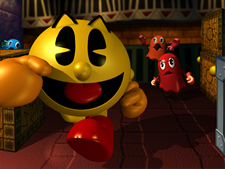As one of the most iconic arcade brands celebrates its 30th birthday and with Pac-Man Party due to launch for the Nintendo Wii, we thought it only right to take a look at how, in a world where games are becoming more technically challenging and need to include all sorts of gimmicks and features to keep the player interested, Pac-Man remains just as popular with players now as it was when it first launched in the 80s, when it caused a yen coin shortage in Tokyo, Japan.

Reigning as one of the top pop cultural icons since his introduction in 1980, Pac-Man remains a global phenomenon and has become the biggest selling arcade machine of all time - realising over 350,000 units while yielding hundreds of products including video games.
Google’s decision to include a playable Pac-Man Google Doodle recently, led to almost five million wasted hours and cost the economy around $120m, according to Tony Wright of Rescue Time (a tool that enables businesses to measure how time and attention is being spent). Wright estimated that Google had around 505 million unique users on the day the Pac-Man Google Doodle went live and that the game consumed 4,819,352 hours of employee time.
Originally entitled Pakku-man after the Japanese onomatopoeic phrase for the sound of opening and closing the mouth - it was formally launched as Puck Man and finally re-badged as Pac-Man on entering the US market. Rumoured to be inspired by a pizza missing a slice, the game designer actually derived Pac-Man’s form from the idea of eating and the Japanese character for ‘mouth’ - the first incarnation of the game used a palette of just 16 colours and reproduced on a screen made up of only 224 by 288 pixels.
While Namco may get the credit for developing the most popular arcade game of all time, with Toru Iwatani taking just 18 months to develop the game, it was Midway that marketed it to the US and saw sales fly through the roof. Nobody had ever seen a game like it and it became an instant hit, catching everyone by surprise. Pac-Man’s success naturally led to merchandise such as toys, t-shirts, plush dolls and of course foods.
Numerous sequels were also spawned - the most significant of which was Ms Pac-Man in 1981, which was heralded as the first post-feminist videogame icon.
The unique game design inspired game publishers to be innovative rather than conservative and encouraged them to speculate on game designs that broke from existing genres. Pac-Man introduced an element of humour into video games that designers sought to imitate and appealed to a wider demographic than teenage boys.
##image2##
Pac-Man in its simplest form could be considered one of the most innovative products of its time thanks to its continued popularity with gamers and shows that games don’t have to be all singing, all dancing to keep a player interested - it is about the gameplay itself. While it has become iconic, with a lot of its popularity today thanks to nostalgia and anything ‘retro’ seen to be fashionable, the game itself is still fun and addictive (a healthy addiction of course) and can still be found in bars and pubs across the world entertaining the masses.
In order to celebrate the game’s achievement and continued popularity, the latest incarnation from Bandai Namco, Pac-Man Party, combines traditional franchise elements with multiplayer sensibilities to bring a dynamic party game filled with mini-games and challenges. Utilising the Wii Remote, the game’s easy to pick-up-and-play controls will have players using their skills and reflexes to compete against one another as they move about several unique virtual game boards. To raise the stakes a bit more, players can strategically build and develop property on any given space, which increases their wealth and provides the quickest route to victory. To help level the playing field and to encourage big comebacks, Power Cookies can be unleashed to increase a character’s size or put extra force and speed behind each movement.
While Namco has reinvigorated the game with these new features in order to appeal to a new audience, there is no doubt that the classic game is where the real appeal lies and Pac-Man Party will also feature a classic mode where players can experience the original arcade versions of Pac-Man, Galaga and Dig-Dug. While other games may come and go there is one thing the industry can rely on - we’ll always have Pac-Man.
First published July, 2010

